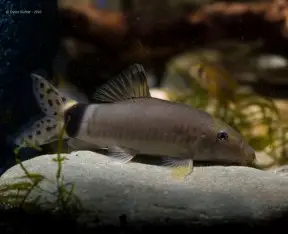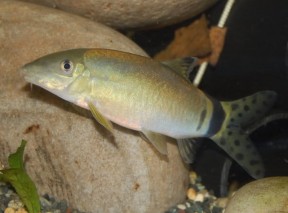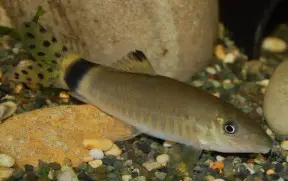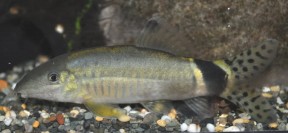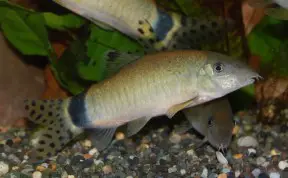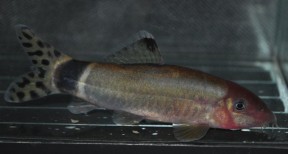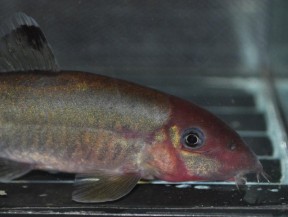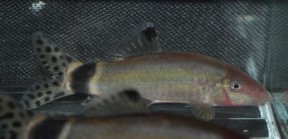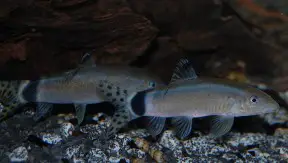Yasuhikotakia splendida
SynonymsTop ↑
Botia splendida Roberts, 1995
Etymology
Yasuhikotakia: named for Dr. Yasuhiko Taki who ‘contributed very much to the study of this group of species’.
splendida: from the Latin splendidus, meaning ‘bright, glittering, splendid’.
Classification
Order: Cypriniformes Family: Botiidae
Distribution
Officially known only from a handful of localities in the Xe Pian river, a tributary system of the Xe Khong (which itself drains into the Mekong river main channel) in Champasak and Attapeu provinces, southern Laos.
If additional populations have been discovered by commercial collectors no details have been made available.
Habitat
According to the description by Roberts (1995) all collection localities were similar and comprised small, swiftly-running, headwater streams draining foothills of the Bolaven Plateau and contained clear water with substrates of rocks and cobbles.
Other botiids present in these habitats were Yasuhikotakia modesta, Ambastaia nigrolineata, misidentified as A. sidthimunki, and an unidentified Syncrossus species.
The author also speculated that the species‘ upstream distribution may be limited by the Tad Saepha waterfall since no specimens were recorded above it.
Maximum Standard Length
90 – 100 mm.
Aquarium SizeTop ↑
For long-term maintenance an aquarium with base measurements of 120 ∗ 30 cm or equivalent should be the smallest considered.
Maintenance
All botiids need a well-structured set-up although the actual choice of décor is more-or-less down to personal taste.
A natural-style arrangement could include a substrate of sand or fine gravel with lots of smooth, water-worn rocks and pebbles plus driftwood roots and branches.
Lighting can be relatively subdued and plants able to grow in such conditions like Microsorum, Taxiphyllum or Anubias spp. can be added if you wish, these having an added benefit as they can be attached to pieces of décor in such a way as to provide useful shade.
Otherwise be sure to provide plenty of cover as Yasuhikotakia spp. are inquisitive and seems to enjoy exploring their surroundings.
Rocks, wood, flower pots and aquarium ornaments can be used in whichever combination to achieve the desired effect.
Bear in mind that they like to squeeze themselves into small gaps and crevices so items with sharp edges should be omitted, and any gaps or holes small enough for a fish to become trapped should be filled in with aquarium-grade silicone sealant.
A tightly-fitting cover is also essential as these loaches do jump at times.
Although botiids don’t require turbulent conditions they do best when the water is well-oxygenated with a degree of flow, are intolerant to accumulation of organic wastes and requires spotless water in order to thrive.
For these reasons they should never be introduced to biologically immature set-ups and adapt most readily to stable, mature aquaria.
In terms of maintenance weekly water changes of 30-50% tank volume should be considered routine.
Water Conditions
Temperature: 20 – 28 °C
pH: 6.0 – 7.5
Hardness: 18 – 215 ppm
Diet
While Yasuhikotakia spp. appear to be chiefly carnivorous by nature they will also eat vegetative matter if available, often including soft-leaved aquatic plants.
They’re largely unfussy feeders but must be offered a varied diet comprising quality dried products, live or frozen bloodworm, Tubifex, Artemia, etc., plus fresh fruit and vegetables such as cucumber, melon, blanched spinach, or courgette.
Home-made foods using a mixture of natural ingredients and bound with gelatin are also highly recommended.
Chopped earthworm can also provide a useful source of protein but should be used sparingly, and while most botiids also prey on aquatic snails though should never be considered the answer to an infestation since they’re not obligate molluscivores.
Once settled into an aquarium they’re bold feeders and often rise into midwater at meal times.
Behaviour and CompatibilityTop ↑
Several SF members have experience with this species and all report it to be milder in temperament than some congeners.
That said slow-moving or long-finned fishes are best omitted with active, pelagic cyprinids such as many Devario, Rasbora, ‘Puntius‘, and some Danio spp. representing more suitable tankmates.
In terms of other bottom-dwellers it should coexist relatively peacefully with most Botia and Syncrossus spp. or in very large tanks, Chromobotia macracanthus. Some cobitid and nemacheilid loaches are also possibilities as are members of Epalzeorhynchos, Crossocheilus, Garra, and many catfishes.
As always, thorough research prior to selecting a community of fishes is the best way to avoid potential problems.
Yasuhikotakia spp. are gregarious, form complex social hierarchies and should be maintained in groups of at least 5 or 6 specimens, preferably 10 or more.
When kept singly they can become withdrawn or even aggressive towards similarly-shaped fishes, and if only a pair or trio are purchased the dominant individual may stress the other(s) to the extent that they stop feeding.
That said they seemingly require regular contact with conspecifics, a fact exemplied by a number of behavioural rituals which have been recorded consistently in aquaria (see ‘Notes’).
Sexual Dimorphism
Sexually mature females are normally fuller-bodied and grow a little larger than males.
Reproduction
No reports of breeding in private aquaria exist but some Yasuhikotakia species are farmed commercially for the hobby via the use of hormones (Y. splendida is not one of them).
A group of 15 adults maintained by UK aquarist Mark Duffill have produced eggs with free-swimming fry observed, and to date this remains the only account of spawning activity in aquaria.
NotesTop ↑
This species first appeared in the trade during 2009 with prices initially variable but in the main prohibitively expensive, and it remains expensive when available.
We’ve seen it on sale under various names including ‘jaguar loach’, ‘splendid loach’ and ‘yellow-tail polka dot loach’.
It appears superficially similar to Y. caudipunctata, Y. longidorsalis, and Y. morleti but can be distinguished from all by a combination of characters of which the most immediately useful include: dark marking forming an unbroken ring around caudal peduncle, this bordered anteriorly and posteriorly by unbroken pale rings; dorsal, anal and caudal fins pale to bright yellow; relatively large, dark, round to oblong-shaped spots on caudal-fin; no dark stripe running across dorsal surface of body; dark, submarginal stripes in dorsal and anal fins relatively well-defined; lower body with a series of 14-19 thin, vertical bars.
In Y. caudipunctata both dorsal and caudal fins usually contain dark spots (vs. caudal-fin only in Y. splendida) and the caudal peduncle marking is relatively indistinct.
Y. longidorsalis and Y. morleti both exhibit brownish (vs. greyish) base body colouration, and the former has a plain dorsal-fin (vs. dorsal-fin with dark, submarginal stripe), while the latter is easily told apart by possession of a dark stripe running across the dorsal surface (vs. no dark stripe).
The genus Yasuhikotakia was erected by Nalbant (2002) to include some former members of Botia which were previously referred to as the Botia modesta ‘group’ following Taki (1972).
Members are defined by the following combination of characters as given by Kottelat (2004): mental lobe not developed in a barbel, with a pair of fleshy papillae at its anterior edge; fronto-parietal fontanelle large and wide; anterior chamber of gas bladder partly covered by bony capsule; posterior chamber large; top of supraethmoid narrow; optic foramen small; anterior process of premaxilla entire, not surrounding a cavity; rostral process long, with a more or less distinct ridge along inner edge; suborbital spine strongly curved backwards and bifid; head naked.
The family Botiidae has been widely considered a genetically distinct grouping since Nalbant (2002), having previously been considered a subfamily (Botiinae) of the family Cobitidae.
Nalbant also moved some previous members of Botia into the new genus Yasuhikotakia based on a number of morphological characters.
Later Kottelat (2004) made further modifications to the taxonomy, raising Chromobotia for B. macracanthus and confirming that species previously included in the genus Hymenophysa should instead be referred to Syncrossus.
The former alteration was based on colour pattern plus some morphological characters and the latter because Hymenophysa not only represents a spelling mistake (McClelland’s original spelling was Hymenphysa) but is a junior synonym of Botia.
More recently Kottelat (2012) erected the genus Ambastaia to accommodate A.nigrolineata and A. sidthimunki, two former members of both Botia and Yasuhikotakia.
As a result of these works the family Botiidae is thus divided into two tribes within which Botia appears to be the most basal lineage:
Tribe Leptobotiini – Leptobotia, Parabotia, Sinibotia.
Tribe Botiini – Ambastaia, Botia, Chromobotia, Syncrossus, Yasuhikotakia.
Phylogenetic studies by Tang et al. (2005) and Šlechtová et al. (2006) have largely confirmed this system to be correct although the latter disagreed with the placement of Sinibotia, finding it to be more closely related to the tribe Botiini.
Ambastaia nigrolineata and A. sidthimunki were found to be more closely-related to both Sinibotia and Syncrossus than Yasuhikotakia, despite being considered members of the latter at the time.
Šlechtová et al. also proposed the use of subfamily names under the following system:
Subfamily Leptobotiinae – Leptobotia, Parabotia.
Subfamily Botiinae – Botia, Chromobotia, Sinibotia, Syncrossus, Yasuhikotakia.
Within these Botia appears to be the basal, i.e., most ancient, lineage and in a more-detailed phylogenetic analysis Šlechtová et al. (2007) confirmed the validity of the family Botiidae with the genera listed above as members rather then being grouped into subfamilies.
This more recent, simpler system is the one we currently follow here on SF.
Some behavioural routines exhibited by Yasuhikotakia spp. have been recorded often enough that they’ve been assigned non-scientific terms for ease of reference.
For example during dominance battles (these occur most frequently when the fish have been introduced to a new tank, or new individuals added to an existing group) the protagonists normally lose much of their body patterning and colouration, a phenomenon that’s come to be known as ‘greying out’.
Such displays will sometimes also happen within an established group as individuals seek to improve social ranking but are usually nothing to worry about.
Interestingly some observations suggest that the character of the highest-ranked, or alpha, fish appears to affect that of the whole group though it must be said that scientific studies of botiid loach behaviour are virtually non-existent.
It certainly seems that they display a degree of ‘personality’ with some specimens being naturally bolder or more aggressive than others, for example.
The alpha is normally the largest specimen within the group and often female.
‘Shadowing’ is an interesting behaviour in which younger individuals swim flank-to-flank with older, mimicking their every movement.
Some keepers report that more than one smaller fish may shadow a larger simultaneously, with even three or four on each side!
The reason for it is unknown; it may relate to a group staying in touch with one another when rivers swell during times of flooding, perhaps reducing drag by swimming ‘in formation’ or having some other communicative function.
It’s been observed in aquaria with both high and low water flow and seems to be habitual to the extent whereby some individuals will shadow other fishes if no conspecifics are present.
Sound also appears to be an important factor in communication since these loaches are able to produce audible clicking sounds, these increasing in volume when the fish are excited.
The behavioural aspects of this phenomenon remain largely unstudied but the sounds are thought to be produced by grinding of the pharyngeal (throat) teeth or subocular spines.
A further curiosity is the so-called ‘loachy dance’ which involves an entire group swimming in a constant, restless fashion around the sides of the tank, usually utilising the full length and height.
The reasons for this are unknown and reports as to when it occurs vary but the most common triggers appear to be the addition of food, fresh water or new conspecifics, and it can last anything from a few minutes to a day or more.
Botiids also often settle at peculiar angles, wedged vertically or sideways between items of décor, or even lying flat on the substrate. This is no cause for alarm and appears to be a natural resting behaviour.
Yasuhikotakia spp. also possess sharp, motile, sub-ocular spines which are normally concealed within a pouch of skin but erected when an individual is stressed, e.g., if removed from the water.
Care is therefore necessary as these can become entangled in aquarium nets and those of larger specimens can break human skin.
Botiids are also susceptible to a condition commonly referred to as ‘skinny disease’ and characterised by a loss of weight.
This is especially common in newly-imported specimens and is thought to be caused by a species of the flagellate genus Spironucleus.
It’s treatable although the recommended medication varies depending on country with hobbyists in the UK tending to use the antibiotic Levamisole and those in the United States Fenbendazole (aka Panacur).
References
- Roberts, T. R., 1995 - The Raffles Bulletin of Zoology 43(2): 463-467
Botia splendida, a new species of loach (Pisces: Cobitidae) from the Mekong Basin in Laos. - Arthainsee, A., T. Leamkom, A. Jutagate, and S. Chundum, 2010 - Journal of Agricultural Technology 6(4): 761-766
Genetic variation of five species of Yasuhikotakia in Thailand using AFLP. - Grant, S., 2001 - Ichthyofile No. 1: 1-8
The Botia modesta complex (Cobitidae, Botiinae). - Kottelat, M., 2001 - WHT Publications, Colombo: 1-198
Fishes of Laos. - Kottelat, M., 2004 - Zootaxa 401: 1-18
Botia kubotai, a new species of loach (Teleostei: Cobitidae) from the ataran River basin (Myanmar), with comments on botiinae nomenclature and diagnosis of a new genus. - Kottelat, M., 2012 - Raffles Bulletin of Zoology Supplement 26: 1-199
Conspectus cobitidum: an inventory of the loaches of the world (Teleostei: Cypriniformes: Cobitoidei). - Nalbant, T. T., 2002 - Travaux du Museum d'Histoire Naturelle 'Grigore Antipa' 44: 309-333
Sixty million years of evolution. Part one: family Botiidae (Pisces: Ostariophysi: Cobitoidea). - Nalbant, T. T., 2004 - Travaux du Museum d'Histoire Naturelle 'Grigore Antipa' 47: 269-277
Hymenphysa, Hymenophysa, Syncrossus, Chromobotia and other problems in the systematics of Botiidae. A reply to Maurice Kottelat. - Taki, Y. and A. Doi, 1995 - Japanese Journal of Ichthyology 42(2): 147-155
Two new species of the cobitid genus [ì]Botia from the Lao Mekong Basin. - Tang, Q., B. Xiong, X. Yang, and H. Liu, 2005 - Hydrobiologia 544(1): 249-258
Phylogeny of the East Asian botiine loaches (Cypriniformes, Botiidae) inferred from mitochondrial cytochrome b gene sequences. - Tang, Q., H. Liu, R. Mayden, and B. Xiong, 2006 - Molecular Phylogenetics and Evolution 39(2): 347-357
Comparison of evolutionary rates in the mitochondrial DNA cytochrome b gene and control region and their implications for phylogeny of the Cobitoidea (Teleostei: Cypriniformes). - Šlechtová, V., J. Bohlen, and H. H. Tan, 2007 - Molecular Phylogenetics and Evolution 44(3): 1358-1365
Families of Cobitoidea (Teleostei; Cypriniformes) as revealed from nuclear genetic data and the position of the mysterious genera Barbucca, Psilorhynchus, Serpenticobitis and Vaillantella. - Šlechtová, V., J. Bohlen, J. Freyhof, and P. Ráb, 2006 - Molecular Phylogenetics and Evolution 39(2): 529-541
Molecular phylogeny of the Southeast Asian freshwater fish family Botiidae (Teleostei: Cobitoidea) and the origin of polyploidy in their evolution.
